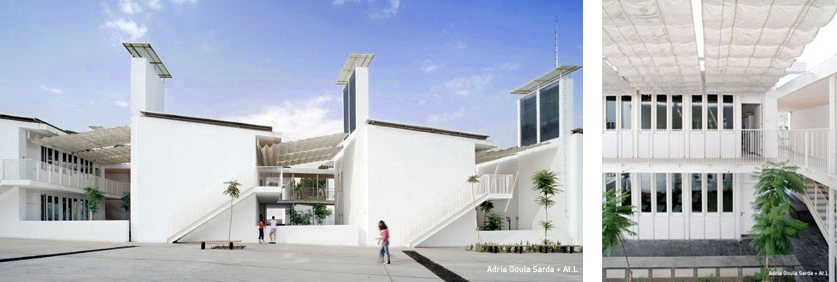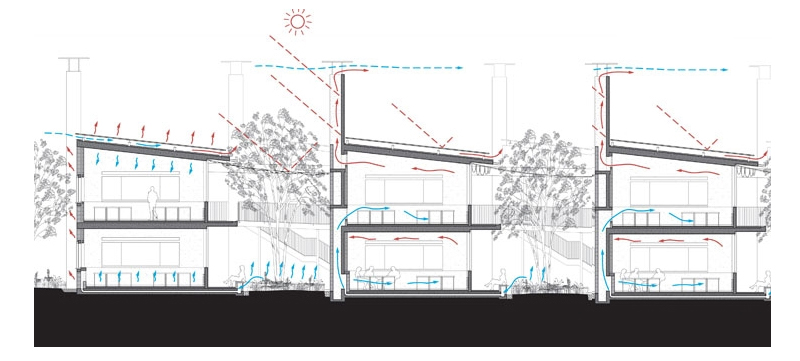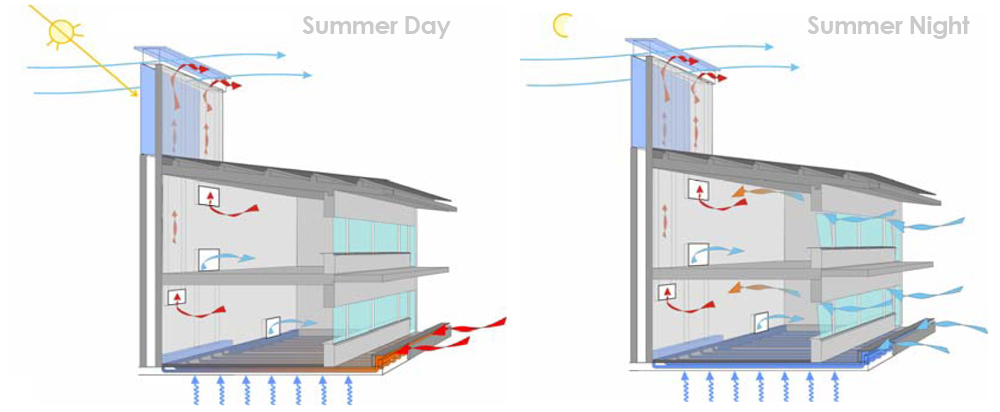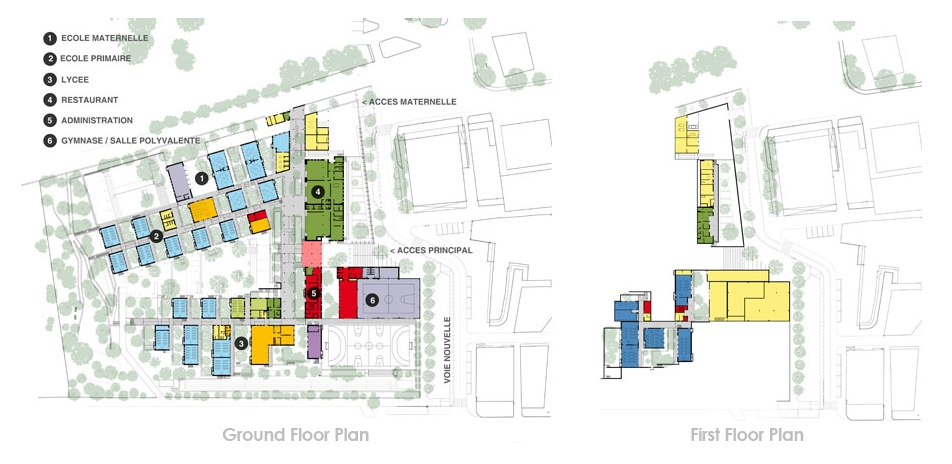Karim Elgendy
In late 2008 the French President Francois Sarkozy inaugurated a new French school in Damascus, Syria. The French school, known as Lycée Charles de Gaulle, follows the french educational system and is accreddited by the French ministry of education. The school was designed by the French architects Ateliers Lion together with the German environmental engineering firm, Transsolar.

Image 1. Night view of school central courtyard showing the solar chimneys. Copyrights: Adria Goula Sarda, Ateliers Lion
The brief for the design team was to to develop a campus for the school with a capacity for 900 students ranging from kindergarten to high school. The design team was also tasked to develop a campus that embodies sustainability by using low-technology solutions for ventilation and conditioning of the school spaces, while maintaining the thermal comfort levels required for students in an educational environment.
The design
In response, the design team’s concept is one that was not only attuned to the local climate, but which relied mostly on passive design strategies to achieve the required comfort levels. The design of the school emphasized using local materials and revived a number of passive design strategies that were common in traditional Middle Eastern architecture. The design of the school was shaped by the need to respond to Damascus’s dry desert climate with its hot days and cold nights. The project’s design goals were to optimize classroom ventilation using natural ventilation, to naturally condition the classroom spaces especially during the summer, and to develop outdoor spaces that are usable by students and teachers.
The masterplan of the school reflected these goals. The school’s complex- whose area totals to 5600 Square meters- was made up of two clusters of small buildings, each with two stacked classrooms ( Figure 1).The building clusters are connected via small courtyards covered with light removable shading (Images 2 and 3).
The removable shading devices above the courtyards provide solar protection during summer days and are opened for cooling at night by radiation to the sky. In winter the operation of the solar shading is reversed, opening it during the day to capture solar gains and closing it at night to prevent their loss to the clear night sky (Image 3).

Image 2 (left), shaded courtyards between classroom buildings. Image 3 (right), courtyard shading and ventilation inlet at courtyard base. Copyrights: Adria Goula Sarda, Ateliers Lion
This layout produced shaded and landscaped courtyard spaces around the classrooms, creating a walkable outdoor microclimate connecting the classrooms and serving as an environment for social interaction between students (Images 4 and 5).

Images 4 (left) and 5 (right), student interaction in small shaded courtyards. Copyrights: Adria Goula Sarda, Ateliers Lion
Natural Ventilation and Passive cooling
The passive ventilation and cooling of the school’s classrooms is achieved through a combination of passive design strategies. These strategies include the shading and cooling of the classroom roofs to reduce the solar heat gain inside the classrooms, the moderation of the indoor temperature using the buildings’ thermal mass, and the use of a natural ventilation strategy inspired by traditional architecture.
The ventilation strategy used in the school is based on the use of Wind-assisted solar chimneys as outlet wind towers pulling warm air out of the stacked classrooms and pulling fresh air into the two classrooms to replace it. The incoming fresh air is drawn into the classrooms through their windows, bringing fresh air from the shaded microclimate of the courtyards whose temperature is moderated through shading and vegetation. Fresh air is also drawn from the courtyard into the lower classroom through miniature earth ducts embedded in the ground floor slab. The function of the earth ducts is to pre-cool the air temperature further before it comes into the classroom, by maximizing its contact with the earth, which has an almost steady temperature year round.
This ventilation strategy is very similar to that found in traditional Iranian architecture where an outlet wind tower was used to pull warm air from a house, and where fresh air was pre-cooled by bringing it through underground chambers where it comes in contact with the earth and a qanat , or an underground water canal, before it reaches the indoor spaces it is meant to ventilate and cool. During the winter the earth ducts reverse their role, warming cool winter air as it comes into contact with earth’s steady temperature. Operable louvers inside the classrooms at air intake and outlet provide occupant control of ventilation. The air intake louvers for the earth ducts can be seen at the bottom of images 3 and 5.
The school’s thick walls also respond to the local climate by making use of the high diurnal swings of the desert climate. The school’s high thermal mass structure improves indoor conditions by absorbing heat during the day and preventing most of it from making its way into the indoor spaces. During night time, cool t air flushes the classrooms , cooling down the structure’s thermal mass and providing comfort for the following day.

Figure 2. Diagram showing integrated shading, cooling and ventilation strategies. Copyrights: Ateliers Lion
Solar chimneys
As discussed above, the solar chimneys are an integral part to the school’s ventilation strategy, used to drive natural cross-ventilation through the classrooms. The chimneys, which dominate the school’s form and skyline, are oriented towards the south and are covered with black-painted polycarbonate sheet to trap solar radiation at the top of the chimney. This trapping of heat enhances the stack effect inside the chimneys, pulling warm air from the classrooms below. The chimneys are also designed to use wind to create negative pressure at the top of the chimney which further improves the stack air movement inside the chimney.
During night time, the thermal mass of the chimney releases the heat it stored during the day and thus continues to draw air through the open windows and the earth ducts, which helps cool the structure further for the following day.

Figure 3. Diagrams showing natural ventilation and cooling during the summer. Copyrights: Transsolar
Karim Elgendy is an architect and sustainability consultant based in London. He can be contacted at: Karim [AT] Carboun [DOT] com
To discuss this article, please join Carboun’s vibrant discussion group on Linkedin. For news and updates on sustainability from around the region, join Carboun’s Facebook page or follow its Twitter feed.

